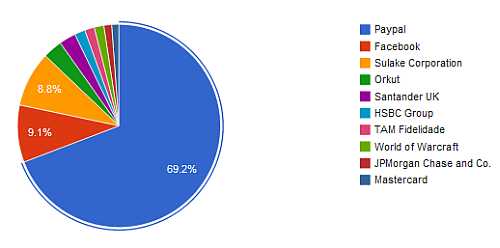Phishing Statistics – The 10 Most Targeted And Phished Companies
According to zdnet.com identity theft is up more than 200% since 2010. On top of that hackers have traded more than 12 million pieces of information in the first quarter of 2012. This is astounding and remains to be said that identity theft is only getting worse, but the real question is who are the hackers really targeting?
So in this article I’m going cover the phishing statistics of the 10 most targeted websites hacker, scammers, and phishers are targeting to steal your identity according PhishTank.com. I should also mention that this data spans from Feburary of 2011 to January of 2012 which is the latest info at the time of this writing.
10 Most Phished Companies
#1 Paypal – 83,145 confirmed attempts ( 69.28%)
#2 Facebook – 10,924 confirmed attempts (9.10%)
#3 Sulake Corporation – 10,592 confirmed attempts (8.83%)
#4 Orkut – 3694 confirmed attempts (3.08%)
#5 Santander UK – 3190 confirmed attempts (2.66%)
#6 HSBC Group – 2029 confirmed attempts (1.69%)
#7 TAM Fidelidade – 1841 confirmed attempts (1.53%)
#8 World of Warcraft – 1703 confirmed attempts (1.53%)
#9 JPMorgan Chase and Co. – 1491 confirmed attempts ( 1.24%)
#10 Mastercard – 1397 confirmed attempts (1.16)
Points To Consider
Now that we have all of this data in front of us let’s consider a few point on why these companies are the prime targets of phishing attacks.
First off, it’s no surprise that PayPal is number one. Of all the different types of phishing scam statistics I’ve seen PayPal takes the cake on this one. In fact I’ve even gone as far as putting an article together talking about how to avoid PayPal scams and what kind of red flags you should be looking for.
Another company that made the list is Facebook. This also doesn’t surprise me simply because if someone can hack your Facebook account they will be able to garner a lot of information about you that could be used to hack other things such as your bank accounts. Hackers also can use the info found on Facebook to build a profile about you to steel other things such as your email account.
However an odd one that surprised me was TAM Fidelidade. I’m not very familier with this particular company but according to Wikipedia they are the company that controls the points program for American Airlines. It seems these scammers are sending out fake emails claiming that if you sign up for their program you will get 2000 points in their frequent flyer program. To learn more about this scam check out this article here.
Fourth, another very highly phished company/website is World of Warcraft. For those not familiar with World of Warcraft it is one of the largest online multiplayer games. Now you might be wondering what does this have to do with phishing attack statistics? In order to play World of Warcraft you have to pay on a subscription basis and it seems phishers are trying very hard to secure other peoples passwords in order to steel their financial details. Here is a link to one of the types of phishing schemes that hackers are using on World of Warcraft.
Finally, of all the top 10 companies that are being attacked by phishing they all seem to have something in common. Of all the companies on the top 10 list, five of them are financial institutions. This would include PayPal, Santander UK, HSBC, JPMorgan Chase, and Mastercard.
On the other hand almost all the rest of the companies on the list are some sort of social media related company such as Facebook, Sulake, Orkut, or World of Warcraft.
So what does this all mean? The majority of phishing schemes are either happening to a financial institution or a website that deals in some form of social media. You can make of it what you want but it seems most phishing scams are targeting these particular two groups.
Final Thoughts…
Overall around 50% of all phishing attacks take place in the United States. No other country even comes close to this many attacks which means we have to be on the defensive and question everything or we could be the next phishing statistic.
Now that you’ve heard my side of the story what are your thoughts? Have you received a phishing email dealing with any of the companies or websites on this list? Feel free to share your thoughts, comments, and stories at the end of this article.
Chris H.


